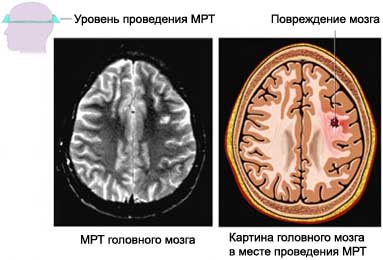MRT – Magnetic resonance imaging
Description MRT
When the MRI uses magnetic waves, to make pictures of structures inside the body. Using a large magnet, radio waves and a computer, MRI can perform two-dimensional and three-dimensional Images.

Reasons for MRI
- Diagnosis of internal injuries or diseases – You can make MRI any part of the body, from head to toe;
- Checking the effectiveness of treatment – after surgery or medication.
How is the MRI?
Preparation for the procedure
If your doctor prescribes a sedative:
- It is necessary to arrange a ride home after the procedure;
- Do not eat or drink for at least four hours before the MRI;
- Take a sedative for 1-2 hours to test, or, as indicated by a physician;
At the hospital before the MRI:
- You will be asked about the following:
- Medical and surgical history;
- Pregnancy;
- Allergies;
- Are there other diseases – If MRI involves the use of a contrast agent, the doctor will ask about the health of the kidneys. People with kidney disease are at risk of complications after the administration of contrast material;
- You will be asked, Do you have any objects in your body, that can interfere with MRI, such as:
- Pacemaker or implantable defibrillator;
- Nerve stimulator;
- Hearing implant;
- Metal fragments in the eyes or other body part (Tell your doctor, If your work involves metal processing);
- Implanted devices, such, how insulinovaya pump;
- Metal plate, studs, Screws, or surgical staples;
- Metal clips after aneurysm surgery;
- Unrecovered bullets from the body;
- Other large metal objects in the body (Dental fillings and braces, usually, no problem);
- You will be asked to remove all metal objects (eg, jewelry, hearing aid, glasses);
- You will also be asked to remove all patches with drugs. They may contain metal elements and cause burns;
- It may be formed X-ray, to check for any metal objects in the body.
Before the procedure:
- It is recommended to wear ear plugs or headphones (MRI machine makes a loud noise);
- If necessary, the vein injected contrast agent.
Description MRT
You will still lie on a moving table. Depending on your state, can connect sensors to monitor heart rate, heart rate and respiration. Table “zaedet” a narrow, closed cylinder. Some MRI machines sides open, and you can see, what's going on outside.
If you are using a contrast agent, before being placed into the machine, in the arm or shoulder inserts a small needle. First saline, to prevent blood coagulation, Dye is injected. Sometimes it can be an allergic reaction to the dye, but this is seldom.
The technician will leave the room. Through the intercom specialist will give you instructions, eg, when you need to hold your breath. You can also talk to the technician. The technician will take photos of interest. Once all the necessary images table “leaves” of MRI apparatus. If you used a needle for intravenous administration of fluids, it is extracted.
If you have claustrophobia or you can not lie on a flat table, have open MRI machines. They allow you to be tested without being placed in a narrow cylinder. There are also devices MRI, allows the patient to remain in a sitting position. This can be important for patients with some problems, eg, back trouble.
After MRI
You will be asked to wait a bit, while the images are studied. You may need to take more pictures.
If you took a sedative, you can not get behind the wheel, operate machinery, or make important decisions, until it wears off.
If you are breastfeeding and received a contrast agent, doctor will tell, when you can resume breastfeeding. According to research, after administration of contrast agent in the child do not appear to be any side effects from feeding breastmilk.
How long will the MRI?
40-90 minutes.
MRT – Will it hurt?
The test is painless. If you have a contrast dye, you may feel a burning sensation when the needle into the vein, and then easily rhigosis, When the dye is injected.
If you have a fear of enclosed spaces, MRI procedure can be very problematic. Your doctor may prescribe a sedative. It is also advisable to ask your doctor about an open MRI machine in, more from all sides and has holes.
MRI results
After testing, the radiologist will study the pictures and send a report to your doctor. Your doctor will tell you about the results and further testing or treatment procedures.
Contact your doctor after MRI
After MRI contact your doctor in the following cases:
- There has been a worsening of symptoms of current disease;
- An allergic reaction or any abnormal symptoms, such as a rash or swelling, If you enter a contrast agent.
